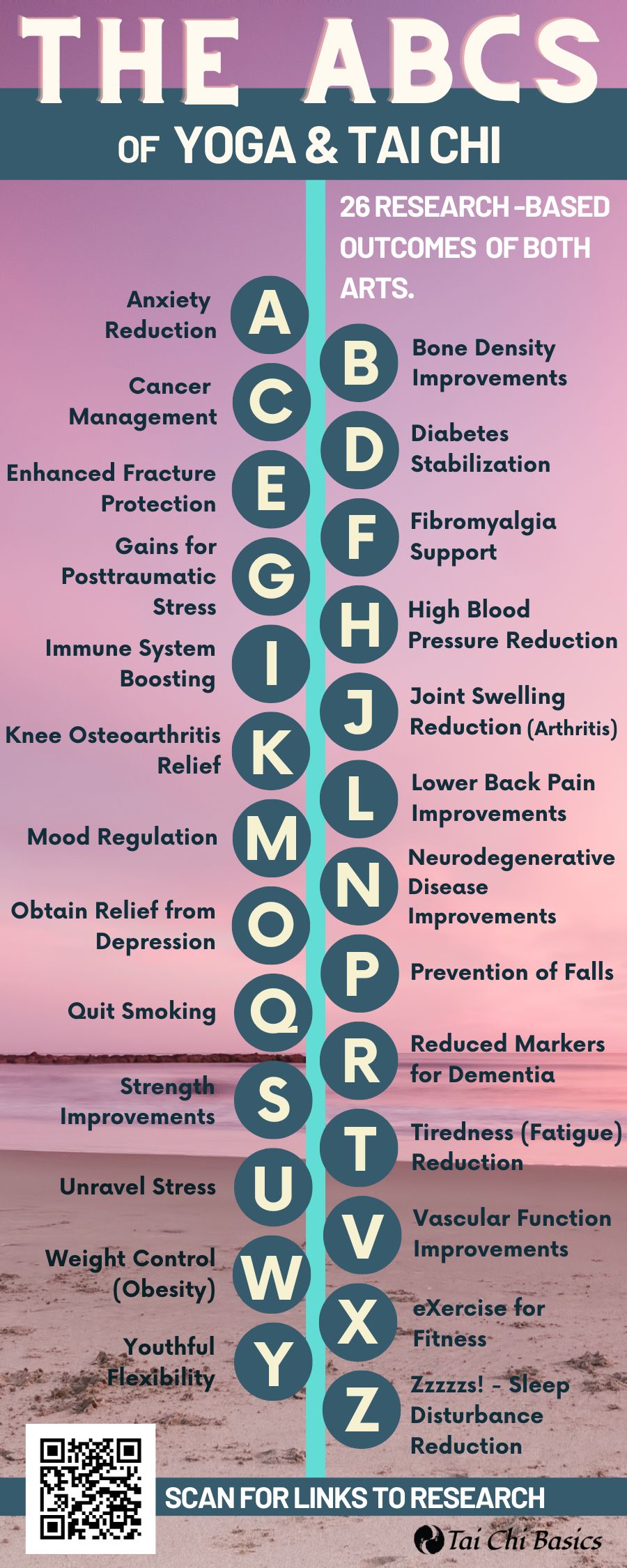In the search for a single activity that simultaneously improves your mental and physical wellness, connects you with others, and can even rehabilitate injuries, many people find themselves on the doorstep of yoga or tai chi. Based on thousands of years of development and now backed by modern research, the benefits of practicing these arts are indisputable. However, choosing between tai chi vs yoga depends on your goals, personality, and physical limitations because these two arts accomplish what they do in very distinct ways.
Both tai chi and yoga are Eastern mind-body practices that combine physical movements or postures with internal attention and breathwork to increase wellness. Yoga involves a series of static postures performed on the floor which are held for a short period of time. Tai chi is a series of movements performed on your feet where a practitioner flows between movements.
With the popularity of yoga and tai chi, most people understand the general differences between tai chi vs yoga. But, there is something more exciting at play that new research is discovering about both arts. Let’s start with a comparison of yoga and tai chi for new practitioners or people who are considering one or the other. Then, we’ll dive into the science behind what is happening physiologically that leads to feeling so amazing after each practice.
Depending on your level of knowledge or interest already, you can use these links to jump to the part of the article that interests you most or take a walk with me from their ancient shared histories up to what they have evolved into today.
Links to Jump to In This Essay
The Shared and Divergent Histories of Tai Chi and Yoga
6 Ways that Tai Chi and Yoga Are Alike
An In-Depth Comparison of the Differences Between Tai Chi vs Yoga
Using Tai Chi or Yoga to Heal From Injury and Disease: Research-Backed Studies
Current Medical Studies on Positive Changes from Beginning Tai Chi or Yoga
The Shared and Divergent Histories of Tai Chi and Yoga
Yoga is accepted as the world’s oldest tradition that pursues and leads to both spiritual and physical development. It was first described in texts known as the Rig Veda 5000 years ago but there is evidence of oral transmission that predated the written accounts. Yoga grew into what we know it to be today as it was recorded and improved upon by religions and mystics in an attempt to purify what they were experiencing through song, meditation, prayer, and posture. Risking simplifying a complex system into a short explanation; life is more enjoyable the more aware, alert, and healthy we are. Additionally, society and the global community benefit when each of us is connected to our past, each other, and see how each action we take impacts the world and environment around us. Hard to get more beautiful than that.
Bodhidharma, a Buddhist ascetic, traveled from Northern India to China in the 5th Century. He brought with him the knowledge of meditation and yogic practices and educated the monks of Shaolin temple on stretching, breathing, and concentration with a goal of improving their health and thereby enhancing their meditation. The roots of yoga, the citations from texts like the Bhagavad-Gîtâ, and the adoption of Buddhism are all clear influences on the religions and philosophies of China.
The increase in health and mental development of the Shaolin monks skyrocketed across the following generation and they became revered among the ruling class of China. While this afforded them certain travel privileges and protections, when political winds changed they were also seen as a threat. Add this to the remoteness of their temples, the dangers of travel and robbery, the need to protect their donations, statues, and possessions, and the physical prowess gained by yogic practices takes shape in a very unique way.
Legend holds that by studying animals (another nature homage to yoga) and creating physical regimes based on their movements, the Chinese external martial arts and animal forms like White Crane are born. Later acolytes returned more closely to the internal development of meditation and breathing regimens to create the moving meditation that became qigong and tai chi.
It’s my personal experience that a person can’t go wrong in choosing between tai chi vs yoga. Their origin, focus, and goals overlap extensively. It becomes more of a decision of availability, comfort with the community you join, preference for movement of static postures, and most importantly, which one makes you feel the best and enjoy life more.

6 Ways that Tai Chi and Yoga Are Alike
Aside from a shared origin, there are many aspects that modern tai chi and yoga share related to the basic organization of the arts.
1. Styles and Organization of Yoga and Tai Chi
Both tai chi and yoga have several distinct styles that vary based on what their overall focus is and how strenuous they are. In tai chi, the style is the family name. There might be smaller offshoots from the main family but they are still related. In yoga, there are six main branches of yoga but the classes or “styles” that you would attend are named differently and often define themselves as being related-to but different-than the original art.
| Primary Styles of Tai Chi | Branches of Yoga | Primary Styles of Yoga |
|---|---|---|
| Chen Tai Chi | Hatha | Hatha Yoga |
| Yang Tai Chi | Raja | Vinyasa Yoga |
| Sun Tai Chi | Karma | Bikram Yoga |
| Wu Tai Chi | Bhakti | Kundalini Yoga |
| Wu Hao Tai Chi | Jnana | Katonah Yoga |
| Wudang Tai Chi | Tantra | Iyengar Yoga |
| Cheng Man Ching Tai Chi | Ashtanga Yoga | |
2. They are Practiced in Groups and Alone
This is a very unique aspect to tai chi and yoga. They are both communal arts where practitioners come together to work through the same routine. It is a very comfortable experience in the same way that someone might enjoy assembling for their religion each week. The routine not only serves as a way to organize the physical movements but unites a group with the shared choreography.
I want to share a story here that turned me from a person interested in tai chi into an avid practitioner. I originally learned tai chi in a very small class that met weekly and we would sometimes practice together. A teacher from China was being hosted by a school in Oregon and a friend asked if I wanted to travel up for the workshop and get some hiking and camping in. It sounded intimidating at first but I went. There were about 45 participants from all over the U.S. and Canada. We stretched as the instructor introduced himself and joked around. When it came time to do the form I dutifully fought for a place in the back row. We stood silent for a moment and then the 40+ complete strangers stepped out to the left and slowly raised their arms in unison. I immediately felt like I was taking part in something way greater than I could have imagined and felt immediately connected to people from all walks of life. I never looked at tai chi the same way again and experienced a similar feeling when I attended yoga for the first time.
Alternatively, yoga and tai chi can be practiced alone. Many activities can only be done together (dancing) or are done alone except for large events (running). Most practitioners of yoga and tai chi attend a class and practice alone. Many do one or the other based on schedules or time constraints. But the practice is always there. They both are highly accessible and highly communal or individual depending on your needs at the time.
3. Tai Chi and Yoga Are Lifelong Practices
Tai chi and yoga can be something that you just try out or do for a while but they are way more than that. They are “practices” in the greatest sense of the word meaning that you are adding something to your life that can be done until your last days. How many activities can say that?
They are prescriptions that you can return to when you are injured, have low energy, or if life gets out of hand.
They are deeply rooted in philosophies for when you are seeking meaning, feeling disconnected, or trying to answer some of life’s bigger questions.
Their histories, styles, language, texts, health advancements, and cultures can be infinitely explored adding a hobby or interest to your life that never gets boring.
4. Yoga and Tai Chi Increase In Difficulty So They Are Accessible To Anyone
When walking into a yoga studio, the new student and 30 year practitioner will be doing the exact same series of movements. Are they identical? Of course not. The postures might be more difficult or more nuanced for the seasoned practitioner. Or, the form might be altered for a person with mobility issues or things like fibromyalgia. But, it is the same style and form.
When beginning a tai chi class it’s the same way. All participants do the same movements laid down decades ago. Do some people flow better? Are some people in deeper postures? Sure. But it’s all tai chi. Fit practitioners can advance to longer forms or weapons forms. Practitioners with limitations can participate while sitting in a chair. But, it’s all still tai chi.
There are no numbers to report. There is no shame. There are no conversations about what you used to do when you were young. Practitioners continue to get better, stronger, more mentally acute, and more agile. Everyone advances at their our own pace and increases their own level of difficulty.
5. Intended to Improve Your Life Both Inside and Outside of Class
I’m not getting on my tie-dyed soapbox here. A stated purpose of both arts is to teach you skills to carry how good you feel in class out into your day-to-day life. This includes dealing with things that are unexpected. Staying present in adversity. Managing pain. Etc. We all go through things in life. But how well are we managing the tough times?
For most people, when things go wrong our default mode is to disconnect, avoid, lash out, or find comfort in unhealthy behaviors. Yes, when we eventually get to a better place we circle back to getting on our feet or seek help from others. Practitioners of tai chi and yoga have the advantage of staying present and working through it so that the negative effects of life’s troubles are mitigated.
6. Both Arts Combine a Focus on Internal (spiritual) and External (physical) Development
I often get asked why someone should do tai chi vs yoga or any other physical exercise. Yoga and tai chi differentiate themselves from all other arts, even Pilates because of how they advance both our internal and external development.
Let’s start with the external because that is easier to wrap our mind around. You get in better shape, you get more flexible, you become more mobile, and your posture improves. Depending on the style of both, you even get stronger. For yoga this requires advanced postures. For tai chi this requires deeper stances, the longer forms, and possibly push hands or learning weapons forms.
Internal development takes shape in two different ways. The breathwork and moving the mind and focus down into the body separates us from any worries or anxieties that our daily events normally bombard us with. This has immediate effects on our mental state and nervous system. It is similar to what religious folks attain through their community and prayer. Additionally, yoga and tai chi work to build the energy of the body which the body (with its innate intelligence) directs to the organs, tissue, or systems that need it most.

An In-Depth Comparison of the Differences Between Tai Chi vs Yoga
A comparison of tai chi vs yoga is valid because of their shared origin, focus, and how a practitioner benefits from practicing either art. However, the differences between tai chi vs yoga are still dramatic. They typically attract very different people with a select few practicing both arts. We’ll cover that at the end.
For a person that is new, here is a head-on-head comparison to help you decide which practice matches your goals and personality.
10 Essential Factors For Choosing Between Tai Chi Vs Yoga
| Tai Chi | Yoga | |
|---|---|---|
| Goals of the Art and Practitioner | Better posture Balance Relief from pain Reduction in stress Improved mood and outlook Social connection Improved flexibility Improved mobility Better sleep Increasing the body’s energy for immunity and healing Increased strength (style dependent) | Better posture Balance Relief from pain Reduction in stress Improved mood and outlook Social connection Improved flexibility Improved mobility Better sleep Increasing the body’s energy for immunity and healing Increased strength (style dependent) |
| Class Description | A 30-90 minute class with practitioners moving around a large indoor or outdoor space. Form work is typically led by a teacher. Classes break into ability groups to work on specific sections of the form or supporting exercises. Interactions are followed by questions or discussions. There is sometimes partner work. | Typically a 30-60 minute class with each practitioner on their own mat in an enclosed space. An instructor leads practitioners through a series of postures. Classes are quiet, with low light. Interactions between classmates happen before or after. |
| Easy of Learning | Can take 3-4 months to learn a tai chi form before it can be practiced alone. New moves are taught each week and then practiced individually until the practitioner memorizes the form. | Easy to learn and memorization not mandatory if attending class because the instructor guides the class through each pose. |
| Price | On average, $10 per class. Free options available. | On average, $15-$35 per class. Free introductory classes often available. |
| Availability | Introductory courses available online. Available almost everywhere. | Introductory courses available online. Available almost everywhere. |
| Need for Equipment | No equipment needed unless learning weapons forms. | No equipment needed other than a mat and sometimes supports like a pillow which are often provided. |
| Time Commitment | Can be practiced for any amount of time. Progress best made with 1-2 practices per week. More time needed at the beginning to learn the movements of the form. Form can then be practiced in 5-20 minutes depending on style. | Can be practiced for any amount of time. Individual postures can be done for specific needs. The most progress is made from following through the entire series of a style’s postures at least weekly. Individual practice can also be modified to do all the postures for a shorter amount of time. Flexibility of time commitment is one of the greatest advantages of yoga which leads to continual practice. |
| Need for a Teacher | Best learned from an instructor. Options exist to learn introductory material on your own. Can be practiced alone. | Best learned from an instructor. Options exist to learn introductory material on your own. Can be practiced alone. |
| Personal Preference | Classes are in groups, performed in well-lit rooms or outside. Attendees train and interact with others. Classes primarily focus on the movements but can also include history, language, and philosophy. | Classes are in groups, performed in dark, quiet spaces. Attendees train individually under the guide of a teacher. Classes focus on working through the poses. |
| Physical Limitations | Modifiable for all injuries, health concerns, and ages, or made more strenuous for advanced goals. Tai chi forms and meditations can be modified for everyone. Some weapons forms (spear, long pole) and push hands not suitable for everyone. Tai chi can be strenuous at first for people with low energy. In this case the form is shortened. It is also a moving art and helps balance but can be challenging at first if balance is an issue. Tai chi is modified to be done seated with certain populations. While tai chi can be modified, sometimes a class’s pace makes people feel like they need to follow along. So choosing the right class is really important. | Modifiable for all injuries, health concerns, and ages. Yoga is extremely gentle, slow, and easy to adapt for any situation. Yoga is done seated or on the floor so it is perfect for anyone with mobility or balance issues. In a yoga class, postures are held for a specific amount of time. For practitioners who fatigue easily, they can simply stop the posture and wait a few minutes to join in with the next one. Specific postures may be counterproductive for certain injuries but they can just be skipped. |
Differences Between Tai Chi Vs Yoga Energy Development
One place the arts differ greatly is in terms of internal energy development. While yoga is a practice that builds internal energy leading to wellness, it is not often a focus of practice. Practitioners feel better naturally from the flow of internal energy that is achieved by how the original creators of yoga organized the poses.
Tai chi’s postures are similarly organized to promote optimal energy flow. In the case of tai chi and specifically qigong, internal energy is built with the goal of being able to sense it in the body and manipulate it with the mind and breath. Specific “qi” “gong” (energy-set) exercises repeat movements to teach this.
Additionally, tai chi and qigong will direct energy to a specific part of the body or build it in a specific part of the body whereas yoga typically conceptualizes the body as a whole and lets it flow.

Using Tai Chi or Yoga to Heal From Injury and Disease: Research-Backed Studies
With internal or Eastern arts being seen as alternative solutions for health problems, many people are weighing the advantages of tai chi vs yoga to support their doctors suggestions or to get around medications or surgery.
In the most dire of circumstances, confidence has been lost in Western medicine or a diagnosis is serious enough that one of these choices might be their only shot at beating it.
The hopes that many people who are trying to heal from injury or disease have are justified because time and again yoga and tai chi are being proven effective at improving a multitude of conditions. There are two caveats though:
- In most cases they are being undertaken in tandem with Western medicine. Often, the condition improves and treatment or medicine can be reduced but it is never suggested to stop following a medical practitioner’s advice and start a tai chi or yoga regime. Use one to support the other.
- The studies that are done are very specific. If you have fibromyalgia for example and hear that people with your condition benefit from one of these two practices, the question remains, how? Fibromyalgia comes with increases in pain and low energy. Therefore shorter practices with a focus on stamina are very important.
If this seems overwhelming to you, know that you are not alone. We as instructors are here for you and love students who say “Hey! These are my current limitations, how can I modify what I am doing in class?” This happens on a weekly basis for me in tai chi class where I am reducing the number of repetitions, reducing the amount of time, limiting deep stances, or making suggestions to take shorter steps. People with injuries often actually have an advantage over many practitioners because they have learned how to advocate for themselves. Tai chi and yoga are supposed to improve your life. If it isn’t working, speak up! So many people make huge progress from one little tweak while others keep silent and move on to try something else.
Rather than present you just with a list of the medical benefits of both arts, I want to link you to the studies so that you can feel confident that tai chi or yoga can help you. Secondly, you don’t need to be a scientist to read these. What you are looking for is that the population they tested is similar to you: say; male and female adults age 30-50. Then you want to see what they did to get the results: say; practice for every other day for 12 weeks. Lastly, you want to see what the study subjects reported so you know what to look for and be hopeful about: say; a 40% reduction in pain and increased mobility.
Current Medical Studies on Positive Changes from Beginning Tai Chi or Yoga (Click to open)

Can You Practice Tai Chi and Yoga Together?
Lastly, I hope you weren’t coming here for a showdown! Yes, in my heart-of-hearts I am a tai chi practitioner but see yoga and its millions of practitioners as a sister-art and as siblings. If anything, I am afraid that if you were choosing between tai chi vs yoga that I may have made your decision more difficult!
So that begs the question; why not try tai chi and yoga together?
Expense aside and aside from attending two classes, these arts not only improve your mental and physical health independently but they are mutually beneficial. They also give you more opportunities to practice and doing one can help you improve the other. Here’s how:
- Bad weather, on vacation, or not enough space? You have yoga.
- Want to get outside? Step out in your yard or driveway for 12 minutes and do tai chi.
- Sitting too much throughout your work day? Do tai chi.
- Restricted in mobility because of an injury? You have yoga.
- Want to get deeper in your tai chi stance? Work on flexibility in yoga.
- Have trouble concentrating in yoga? Concentration is easier in tai chi because of the kinesthetic movements.
If you are an avid practitioner of either art, try doing tai chi and yoga together, even for a short amount of time. You don’t need to commit to both forever. But the arts approach the same goals in such opposite ways that it can show you things you need to work on to make your preferred practice even better.


